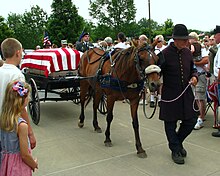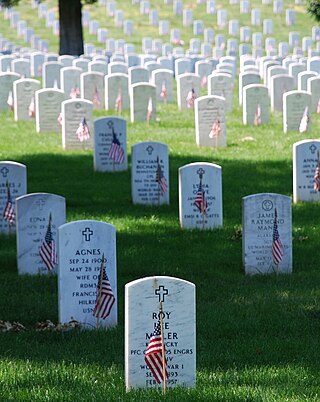
Memorial Day is a federal holiday in the United States for mourning the U.S. military personnel who have died while serving in the United States armed forces. It is observed on the last Monday of May. From 1868 to 1970 it was observed on May 30.

Arlington National Cemetery is one of two national cemeteries run by the United States Army. Nearly 400,000 people are buried in its 639 acres in Arlington, Virginia. There are about 30 funerals conducted on weekdays and 7 held on Saturday. The other Army cemetery is in Washington, D.C. and is called the U.S. Soldiers' and Airmen's Home National Cemetery. All other national cemeteries are run by the National Cemetery System of the Department of Veterans Affairs.

Camp Nelson Confederate Cemetery is a historic cemetery located near Cabot in northern Lonoke County, Arkansas and is near the site of a Confederate military camp Camp Hope, where 1,500 Confederate soldiers died during an epidemic during the fall of 1862. Camp Nelson Cemetery is located on Rye Drive, just off Cherry Road, just off Mt. Carmel Road in north Lonoke County about 2 miles east of Cabot.

The United States National Cemetery System is a system of 164 cemeteries in the United States and its territories. The authority to create military burial places came during the American Civil War, in an act passed by the U.S. Congress on July 17, 1862. By the end of 1862, 12 national cemeteries had been established. A national cemetery is generally a military cemetery containing the graves of U.S. military personnel, veterans and their spouses, but not exclusively so. The best-known national cemetery is Arlington National Cemetery in Arlington County, Virginia, adjacent to Washington, D.C. Some national cemeteries, especially Arlington, have graves of civilian leaders and other national figures. Some national cemeteries also contain sections for Confederate soldiers. In addition to national cemeteries, there are also state veteran cemeteries.
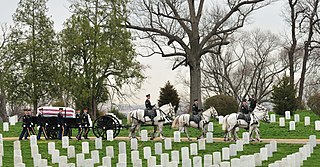
A military funeral is a memorial or burial rite given by a country's military for a soldier, sailor, marine or airman who died in battle, a veteran, or other prominent military figures or heads of state. A military funeral may feature guards of honor, the firing of volley shots as a salute, drumming and other military elements, with a flag draping over the coffin.

Camp Butler National Cemetery is a United States National Cemetery located a few miles northeast of Springfield and a few miles southwest of Riverton, a small town nearby to Springfield, in Sangamon County, Illinois. It was named for the Illinois State Treasurer at the time of its establishment, William Butler. Administered by the United States Department of Veterans Affairs, it occupies approximately 53 acres (21 ha), and is the site of 19,825 interments as of the end of 2005. Camp Butler National Cemetery was placed on the National Register of Historic Places in 1997.

Philadelphia National Cemetery is a United States National Cemetery located in the West Oak Lane neighborhood of Philadelphia, Pennsylvania. It was established in 1862 as nine leased lots in seven private cemeteries in the Philadelphia region. In 1881, the current location was established and the graves of soldiers were reinterred from the various leased lots. It is administered by the United States Department of Veterans Affairs, and managed from offices at Washington Crossing National Cemetery. It is 13 acres in size and contains 13,202 burials.

Crown Hill National Cemetery is a U.S. National Cemetery located in Indianapolis, Marion County, Indiana. It was established in 1866 on Section 10 within Crown Hill Cemetery, a privately owned cemetery on the city's northwest side. Administered by the United States Department of Veterans Affairs, the National Cemetery encompasses 1.4 acres (0.57 ha) and serves as a burial site for Union soldiers who fought in the American Civil War.

Cypress Hills National Cemetery is a 18.2-acre (7.4 ha) cemetery located in the Cypress Hills neighborhood of Brooklyn, New York City. It is the only United States National Cemetery in New York City and has more than 21,100 interments of veterans and civilians.

Camp Chase was a military staging and training camp established in Columbus, Ohio in May 1861 after the start of the American Civil War. It also included a large Union-operated prison camp for Confederate prisoners during the American Civil War.

Grafton National Cemetery is a United States National Cemetery located in Grafton, West Virginia. It encompasses a total of 3.2 acres (1.3 ha). Along with West Virginia National Cemetery, it is one of two United States Department of Veterans Affairs national cemeteries in West Virginia, both of which are located in Grafton. The first interments took place in 1867 for casualties of the American Civil War in West Virginia.
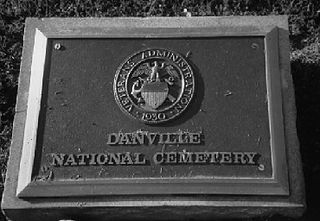
Danville National Cemetery is a United States National Cemetery located in the city of Danville, in Boyle County, Kentucky. Administered by the United States Department of Veterans Affairs, it has 394 interments and is currently closed to new interments.

Perryville Battlefield State Historic Site is a 745-acre (3.01 km2) park near Perryville in Boyle County, Kentucky. The park continues to expand with purchases of parcels by the Office of Kentucky Nature Preserves' Kentucky Heritage Land Conservation Fund and the American Battlefield Trust. An interpretive museum is located near the site where many Confederate soldiers killed in the Battle of Perryville were buried. Additionally, monuments, interpretive signage, and cannons mark notable events that occurred during the battle. The site became part of the Kentucky State Park System in 1936.

The John Hunt Morgan Memorial in Lexington, Kentucky, is a monument created during the Jim Crow era, as a tribute to Confederate General John Hunt Morgan, who was from Lexington and is buried in Lexington Cemetery. The monument was originally situated on the Courthouse Lawn at the junction of North Upper and East Main Street, but was moved to Lexington Cemetery in 2018.

The Confederate Monument in Cynthiana is located on the outer edge of Cynthiana, Kentucky in Battle Grove Cemetery. It was the first monument to the Confederate States of America dedicated in the State of Kentucky, and long believed to be the first Confederate memorial anywhere. Due to the 32nd Indiana Monument having been moved from its original location, the Cynthiana monument is the oldest Civil War monument still standing at its original location, where the second Battle of Cynthiana started, in the then-new town cemetery.
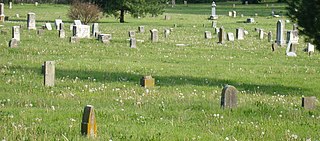
African Cemetery No. 2, also known as The Cemetery of the Union Benevolent Society No. 2, is a historic burial site located in Lexington, Kentucky, United States.

The Confederate Memorial in Nicholasville is a historic statue created in the Jim Crow era and located on the Jessamine County courthouse lawn in Nicholasville, Kentucky, ten miles south of Lexington, Kentucky.
Patrick R. Cleburne Confederate Cemetery is a memorial cemetery located in the city of Jonesboro, Georgia, United States. It was named in honor of General Patrick Cleburne. This cemetery was a burial site for Confederate soldiers who died in the Battle of Jonesboro in 1864. This cemetery is open daily until dusk. It is one of six Confederate cemeteries maintained by the Georgia Building Authority.

Miramar National Cemetery is a federal military cemetery in the city of San Diego, California. It is located in the north west corner of the Marine Corps Air Station Miramar on the grounds of old Camp Kearney (1917) and Camp Elliott (1942).

Confederate Rest, in Forest Hill Cemetery, Madison, Wisconsin, is the northernmost Confederate graveyard in the nation. 140 Confederate prisoners of war who died under Union captivity lie in it.


